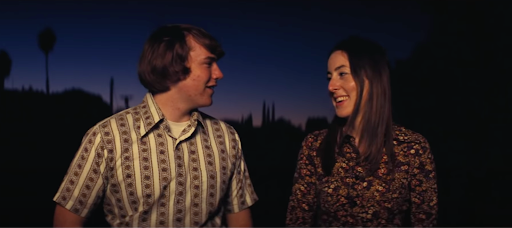In some instances, films that provoke nostalgia in their audiences get praised much more. This phenomenon, in my personal opinion, occurs for many with “Licorice Pizza.”
The film, starring Alana Haim and Cooper Hoffman, tells the story of their characters’ young romance in the San Fernando Valley in 1973; however, I contest that there is not much plot at all. Sure, the two main characters have their motives, but “Licorice Pizza” progresses only through incomplete subplots and the passage of time.
Nonetheless, I can acknowledge the beauty in this structure. After all, aren’t these factors the driving force behind any real world relationship? I applaud director Paul Thomas Anderson for converting this realism to the silver screen.
This does not let “Licorice Pizza” off the hook, unfortunately. Without spoiling any additional plot, the main characters’ relationship consists of a 25-year-old girl and a 15-year-old boy. While this may have been normalized in the ’70s (I would not know), I was left with a sour taste in my mouth watching each character’s actions.
Both Haim and Hoffman’s performances do deserve some praise, but I feel their characters are hard to root for. Additionally, beyond those two, there is little to know (or care about) with the supporting cast. Bradley Cooper is the lone exception, as he is a hysterical addition to the film, in spite of such little screen time. The rest of the cast have very limited interactions with the main characters, making them easily forgettable.
That’s not to say I entirely disliked the film. In reference to my earlier point regarding nostalgia, the ’70s setting is one that Anderson truly captures. With my showing of the film being on 70mm film, I feel the intended aesthetic was fully encapsulated in my viewing experience. The aged look of “Licorice Pizza,” as well as its cinematography, transported me to a world I could never experience today.
My only wish is that I got to witness a deeper, more meaningful story testifying to the power of love. Instead, I came away feeling the world-building efforts were wasted on shallow characters.
The varying opinions of critics and audiences can be affected by a multitude of factors. Perhaps someone who lived through the ’70s would appreciate the film more, but for myself, I thought it lacked in too many areas to fall in love with it. Time will tell how “Licorice Pizza” is remembered, especially with awards season firmly upon us.
“Licorice Pizza” is now showing in select theaters on 70mm film, whose aspect ratio and resolution is most reflective of the director’s original vision. The film is available nationwide in standard formats on Dec. 25.








